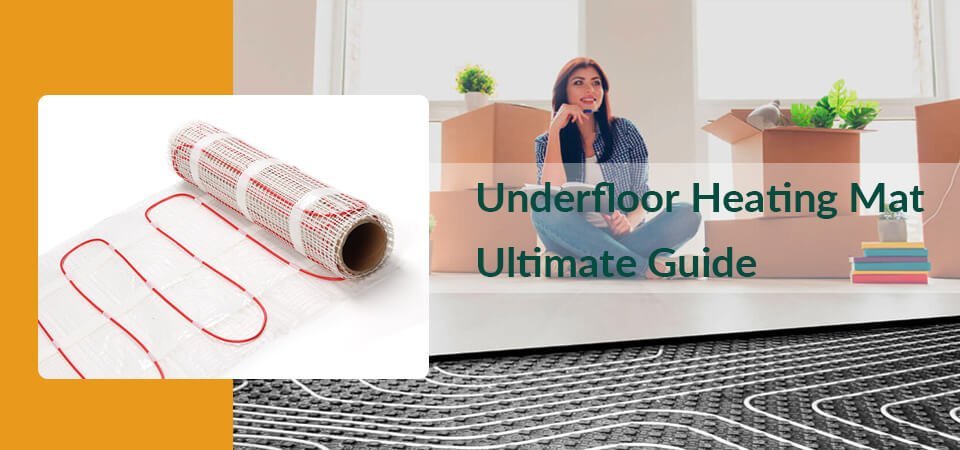
If you are looking for a complete buying guide of the electric underfloor heating mat, then you are in the right place. This guide is from a professional manufacturer’s view, let’s jump to have a look.
- Chapter 1: What is floor heating mat
- Chapter 2: How to select the proper heating mat?
- Chapter 3: Popular Underfloor Heating Mat Review
- Chapter 4: How to install Heating mats?
- Chapter 5: Tips for Buying an underfloor heating mat
- Chapter 6: Heating Mat FAQ’s
- Conclusion
Chapter 1: What is floor heating mat
As a core part of an electric floor heating system, the underfloor heating mat is mainly used to provide radiant heat to your cold floor.
It’s an ideal heating solution for the bathroom, kitchens its suitable for commercial buildings as well as residential buildings.
1.1 What is the underfloor heating mat?
Heating Mat = Heating cable + Adhesive glass fiber mesh
As you can see from the formula above, each Heating mat consists of adhesive glass fiber mesh and heating cable, and they worked together with the proper power connection.
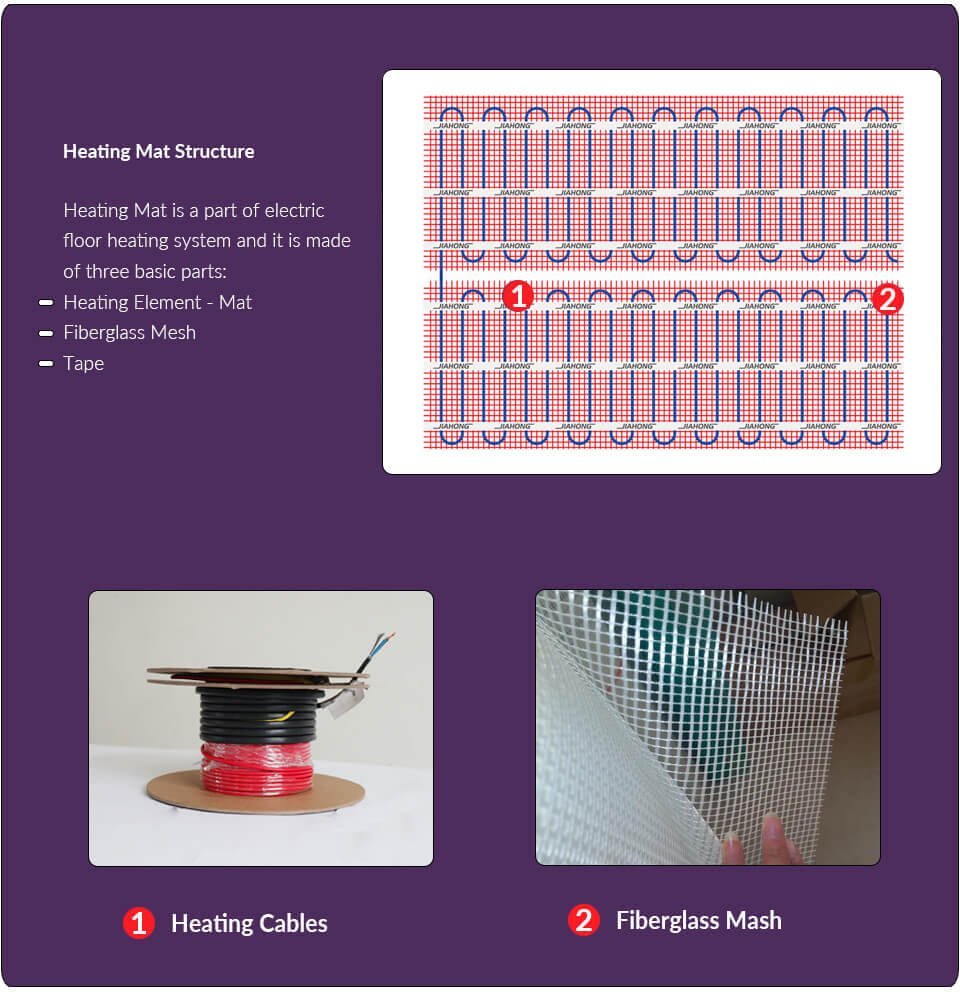
Graphic: underfloor heating mat
The most important feature is that this particular width of the viscous mesh is very easy to lay.
However, in any electric floor heating system, all heating mats need to work with a thermostat to provide secure floor heating. The mat can continuously provide heat to the outside, and a thermostat can adjust the heat output.
1.2 Different types of Electric Underfloor Heating Systems
As I mentioned above, different forms of the floor heating system exist do check the most appropriate option to warm up your place.
The electric underfloor heating system type totally depends on the requirements of the place. You can never specify the type of heating system instantly.
- Loose Wire Underfloor Heating System
- Sticky Heating Mat System
- Aluminum Foil Heating Mat System

Graphic: Electric Floor Heating System
If you have a room with an asymmetrical shape, you can go for a free wire flexible heating system, and this is a very convenient option to fit in different corner-based areas.
Whatever your house shape is, Jiahong can manage easily the whole heating system because it’s very easy to understand.
Ease of installation matters a lot; you don’t worry about tools and material which you need to manage for the installation process is always provided heating mat company.
In-underfloor heating mat is easy to install and very cost-effective to operate; in short, we can say your feet will love to enjoy a cozy environment in cool winter.
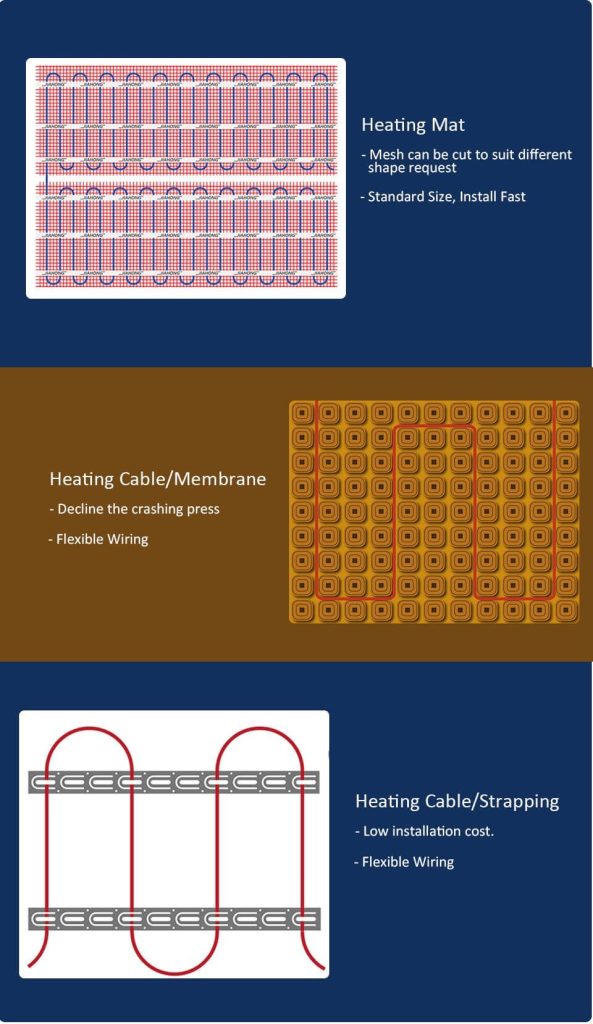
Graphic: Three Different Types of Floor Heating System
The cable can be adjusted under furniture in corners, toilets, washrooms, and in kitchens.
Always consider which heating solution is easy to install electric floor heating mats are very easy and quick to install.
This is a preferred heating solution as compare to a loose wire heating system because it’s a simple roll-out process, especially the sticky mat system are ideally hidden underfloor.
How does the Heating Mat work?
Heating mats work on the radiant floor heating system, and they provide heat indirectly like its not like air warm up. It radiates heat from the floor.
Also, it can help to absorb all energy from near objects as a result whole room or building adjust the required temperature level.
Heat transmits through radiations and is caused by electromagnetic waves.
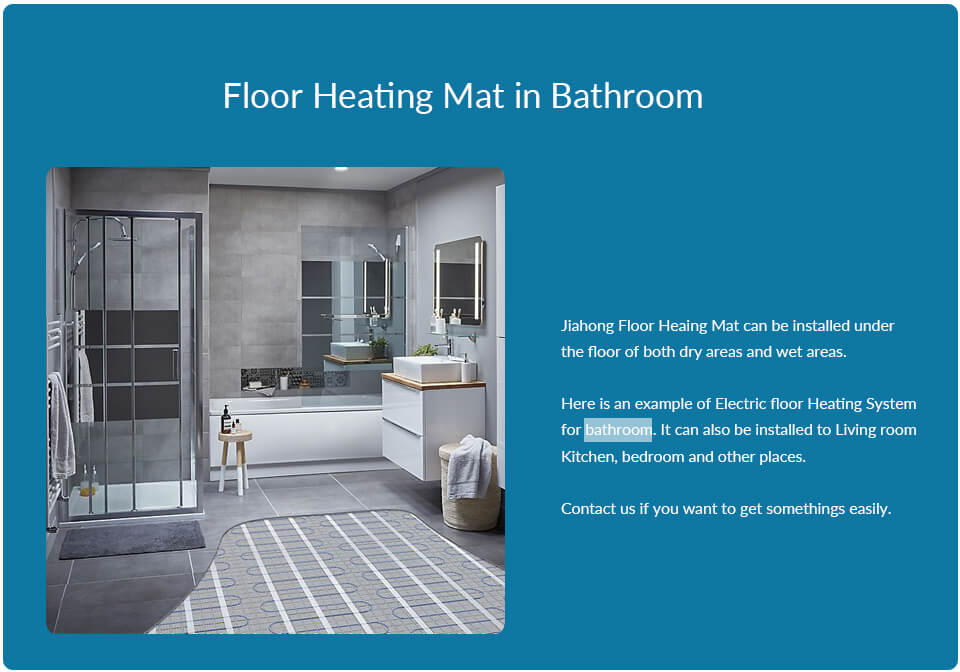
Graphic: Floor Heating Mat in Bathroom
1.3 Best Option for DIY Installation
If you are going to DIY your electric floor heating system, the heating mat is your best option.
Efficient heating system
There are few types of heating system which helps to warm up the room like a water-based heating system, electric and radiant heating system.
Jiahong provides constant heat without interruption and consumes very less amount of energy helps to reduce the bill.
No Effort required to install
The installation process of heating mats has no complication even you can set up floor heating mats by yourself.
Another plus point thermostat option can also be connected, which helps to control the temperature automatically, or you can set your time frame.
WIFI thermostat allows people to regulate the temperature level from your mobiles or other electronic devices.
Jiahong can provide them with heating thermostats include smart thermostats and common thermostats.
If you have some issues to understand, read the thermostat sourcing guide.
Normally heating mats are suitable for specific shape areas like rectangular or square.
What things required to make it functional?
- On-site flexibility
- Heating wire required to attach adhesive mesh material
It helps to arrange heating cables in very east to handle heating mats, and the preferable thing is to fit in any room size or shape.
- Easy installation within a short time
- Adhesive strips
- Fit in any size
- Suitable for any shape
- Easy to use layout
Chapter 2: How to select the proper heating mat?
There are many factors that need to be considered when purchasing an underfloor heating mat. We mainly discuss the five most important issues here. This is also the basic condition for the right product you can purchase. So let’s see if they all contain that content.
2.1 Voltage Selection
If you have the experience of purchasing electrical products, then you must have the feeling that the sales staff will ask you where the market is?
In addition to providing a more reasonable product plan later, it also has an important purpose to obtain the voltage of the target market.
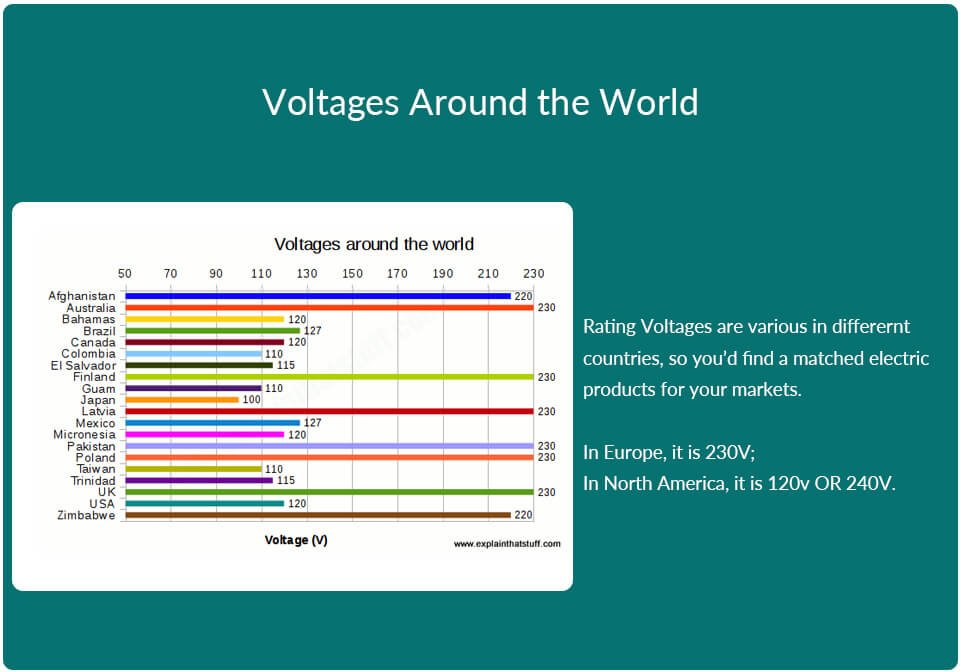
Graphic: Rating Voltages Around the World
In China, our civilian voltage is 220V, and in the US, both 120V and 240V are available. If you are in Europe, the standard voltage is 230V. Therefore, the same wattage heating mat for different regions may have different structures or materials.
Using a simple electrical knowledge to explain is P = U2 / R. The voltage applied between the resistors is different, to ensure that the power is constant, then the resistance must be different.
2.2 Type Selection
Different type of floors requires different size and type of heating mats.
If you want to put the heating mat directly under the wooden floor, then our aluminum foil heating mat will be your best option. This type of heating mat can be also directly put under the carpet.
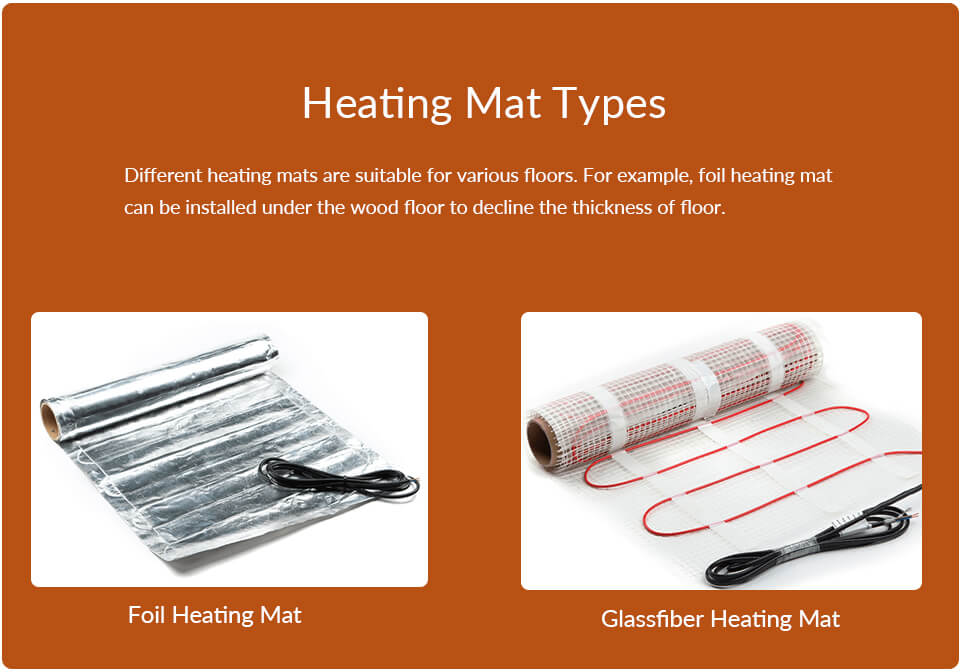
Graphic: Heating Mat Types
For other types of floors, you’d better select a regular heating mat with mesh. This type of heating mat can be used in both wet and dry areas.
Our past 30 years of experience tell us that the glass fiber heating pad has always been one of our best-selling products.
2.3 Cable Power Selection
The power of the wire determines the speed at which the floor temperature rises. A large power heating network will heat up to a predetermined temperature, and a small power heating network takes longer.
For example, a 200W heating net takes 15 minutes to heat the floor of your living room to 30 degrees Celsius, but a 100w heating network may take 30 minutes or more.
In addition to considering the heating time, we also need to consider the problem of power consumption. So the actual final product must be an equilibrium value between heating time and power consumption.
Currently, the regular range of cable power in heating mats is 80w-300w per square meter.

Graphic: underfloor heating bathroom
In cold and wet areas may require a bigger cable power because it is a little hard to warm up the floor quickly. Most end-users will select the mat of 150~200w per square meter.
A dry place like a living room may need the mat with a lower cable power ranged from 80~150w per square meter.

Graphic: Electric UFH Living Room
Therefore, local climatic conditions will affect an important indicator of your purchasing strategy.
How many low-power products with how many high-power products are better? This will be a very important indicator.
We have been providing OEM services to various importers for the past 30 years, and we have grown up with brand distributors. So we know more about your market than you might.
2.4 Connection Method
The way power is connected affects the design of the cable structure. Whether the cable adopts a double-conducting structure or a single-conducting structure determines the diameter of the cable itself, and on the other hand, determines the way to connect the power supply.
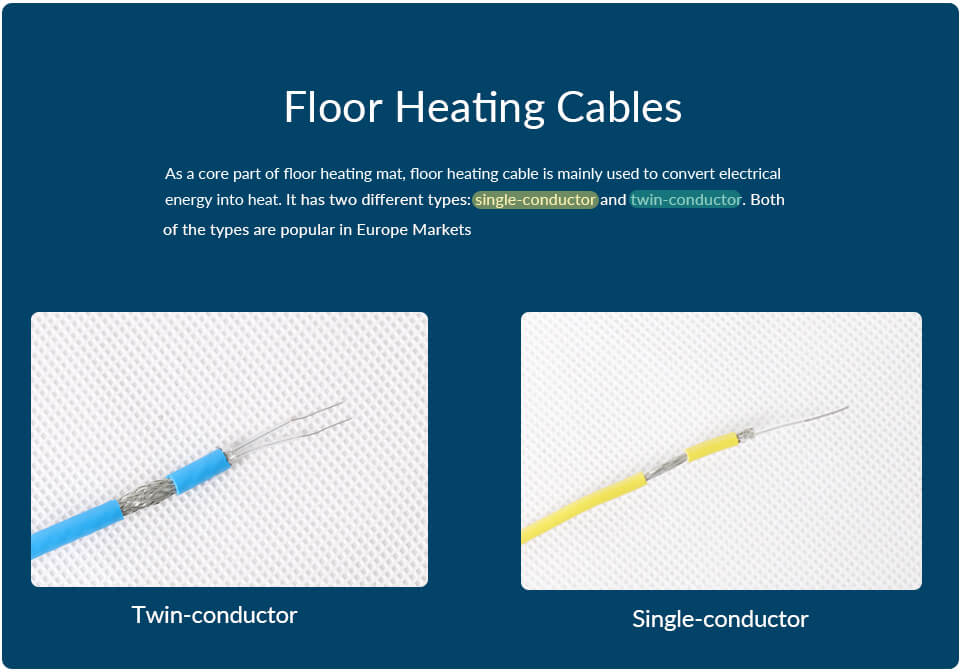
Graphic: Heating Cable Structure
For places where the height of the decoration is limited, a single-conductor cable can effectively reduce the overall height of the floor.
However, most newly built houses have no special restrictions on the thickness of the floor. Therefore, importers are often more willing to purchase double-conductor cable.
How to decide whether a single or double guide structure? Which one is more suitable for your target market?
The single-conductor cable needs two different connection points; on the other hand, twin-conductor cable connects to the power from one point.
Electric floor heating can be applied to newly built houses as well as to old houses.
The restrictions on the height of the floor in the old house renovation may be too high; in the same case, the height of the new house, whether it is a residential house or a commercial building, is much smaller.
So, if your target market has a low height limit, I recommend that you use a dual-conductor structure as much as possible to make the installation easier.
2.5 Insulation Materials
Insulation materials for heating cables require heat resistance and water resistance in addition to insulation properties.
At present, the Insulation materials used for heating cables mainly include fluoroplastics, PVC, low-smoke halogen-free plastics, and so on.

Graphic: Plastic & Its Performance
In terms of insulation properties, fluoroplastics>PVC, fluoroplastics>low-smoke halogen-free plastics. Therefore, Jiahong generally uses fluoroplastic as the insulation material for our heating cable.
However, in some special areas, the law requires the use of some environmentally friendly plastics. At this time, it is generally necessary to make a balance between the heating power and the insulating material.
Sizing Electric Radiant underfloor heating mats
For the end-user, choosing the underfloor heating mat is ideal for your DIY electric floor heating system.
One thing that is important to you is to determine where you need to place the heating pad.
For example, you should determine the living room, kitchen, or bathroom, and which room requires a heating system.
Then you should calculate the actual heated area.
The next chapter will discuss four different popular heating mats, which will help you better understand what it is and what factors you need to consider when purchasing a heating mat from Jiahong.
Chapter 3: Popular Underfloor Heating Mat Review
3.1 WARM-C Mat
WARM-C MAT is a type of underfloor heating mat designed to strict U. S. UL and Canadian CSA standards.

All heating products in North America must be approved by UL and CSA, which is the basic standard for determining whether a product can be sold in the United States.
The WARM-C MAT body is made up of a bi-conductive constant wattage heating cable and an adhesive fiberglass Mesh.
On the one hand, the dual-conductor heating wire only needs a regular wire from the starting end to connect the temperature controller.
On the other hand, the adhesive Mesh not only can be cut to fit different shapes but also easily fixed on the ground. So the installation process is quite simple and suitable for DIY operations.
The Best Selling Warm-c Mat in the Americas is 12w per square foot. You can choose the appropriate size based on the size of the actual space.
3.2 AF-Mat
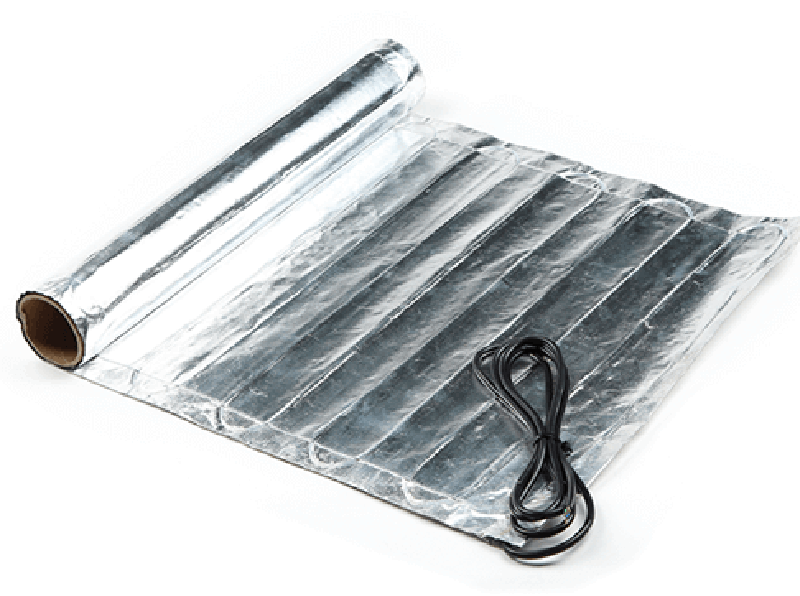
Only 1mm thick and Shallow floor height requirement during the installation, AF-mat can be used directly on wooden floors or under carpets.
AF-Mat is a fully sealed aluminum foil heating pad that is open to the European market.
The aluminum foil bag wrapped around the heating wire is both a heat reflecting film and an electromagnetic radiation absorber.
Therefore, even if directly laid under the wooden floor, it will not produce harmful electromagnetic radiation.
3.3 Mini-D Mat
The Mini-D Mat is the most popular underfloor heating mat in the European market. It has passed CE, EAC, and TUV certification and can be widely used in the European Union and Eastern European markets.

Its main body is a dual-conductor constant wattage heating cable and an adhesive glass fiber mesh.
On the one hand, the dual-conductor heating wire only needs a standard cable from the starting end to connect the temperature controller.
On the other hand, the adhesive Mesh not only can be cut to fit different shapes but also easily fixed on the ground. So the installation process is quite simple and suitable for DIY operations.
The MINI-D MAT is generally installed in thick floors, such as tile, wood, marble, and so on.
You can customize Mini-D Mat with a power range of 80 to 300 watt per square meter.
If it’s used in a dry environment, such as a living room or bedroom, you can choose the cable which wattage range between 80 and 150 watts per square meter;
If it’s relatively humid, like a basement, the bathroom can choose between 160 and 300 watts per square meter, which is relatively powerful.
Of course, you can customize the power of any other products according to your needs or choose our previous hot models.
3.4 Mini-S Mat
The Mini-S Mat is also a kind of underfloor heating mat suitable for the EU market.
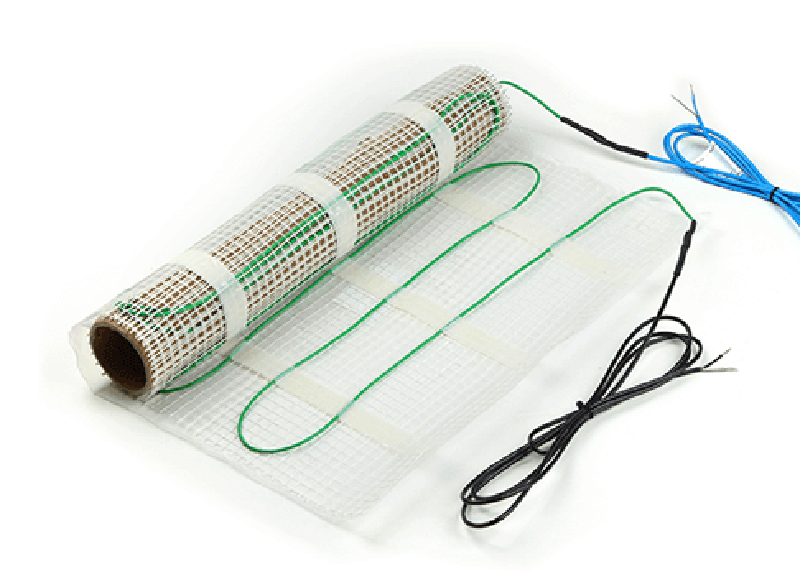
The main body is consists of a single-conductor heating cable and an adhesive fiberglass mesh with a width between 60 and 80 cm, so the overall thickness is between 2.6 and 2.8 mm.
A single-conductor means that two power cables need to be drawn from the start and finish points, which need to be connected to the thermostat at the same time.
Like the Mini-D Mat, the Mini-S Mat is suitable for both wet and dry environments. The installation process is relatively simple, and it is very suitable for DIY installation.
Chapter 4: How to install Heating mats?
Required tools
- The drill which must be cordless
- Glue gun
- Margin trowel
- Knife
- Ohmmeter
Required material
- Thermostat
- Tiles
- Set mortar
- Radiant heat mat
- Grout
- Cement
- Cement board underlayment
Installation problems have plagued our end consumers and even some distributors, such as floor distributors.
It’s hard to get a professional installation process guide through an effective method, and you don’t know much about how to troubleshoot the problem.
4.1 The preparation phase
“Give me six hours to chop down a tree, and I will spend the first four sharpening the ax.” ― Abraham Lincoln
We also need to prepare something for this installation. First, it is necessary to get the tools and materials ready before the operation.
Here I list all the tools that will use:
- Multimeter
- Screwdriver
- Insulation resistance tester
Besides, we also need to check other materials like thermostats, insulation board, reflective foil, Heating Mat.
Materials and tools are ready now, but this job is just the beginning of the preparation. We also need to confirm two things.
- Circle the cable laying area
It is not necessary to put the mat on the whole floor, such as the sofa, TV cabinet, wardrobe, etc. Just lay the cable on the place where your feet touch.
This process may usually have been ready when you designed the wiring.
- Determine the laying direction
Two principles will guide you on how to start this action.
- From the side to the center
- Starts from the place close to the cassette(power connection point);
Now we can push the next phase: implementation. You can directly follow our operation step by step to starting your project.
4.2 The implementation phase
- Clean the floor first to make the floor flat and tide.
- Install the insulation board
- Install the reflective film( Some insulation board contains reflective film, then no need this step)
- Lay the heating mat according to wiring diagram; ( remind some irregular area, the mesh can be cut to fit the shape)
- Install the probe of the thermostat;
- Install Heating Thermostat
- Connect the heating cable with thermostat,
- Connect the thermostat the power;
- Commissioning
1) use a multimeter to detect the insulation resistance and determine that there is no breakpoint
2) Test the heating mat and thermostat work normally
- Applying cement mortar.
Chapter 5: Tips for Buying an underfloor heating mat
Before buying the heating mat, you need to consider different factors like:
5.1 Is electric floor heating right for you?
Based on our experience of the past 30 years, electric underfloor heating is more suitable for the floor heating needs of middle-class families. A simple reason is that its running costs are higher than water UFH.
Despite the need for cold protection in cold regions like Europe, Russia, Canada, and the northern United States, it is indeed a rigid demand. But to be honest, electric floor heating may not save you energy bills.
We know that there are two main types of floor heating options available on the market: Electric Floor Heating and Water Floor Heating.
Let us first compare the difference between electric UFH and Hydrate UFH.

According to our UK customer information, the construction cost of a small household Water UFH project requires at least £800; if it is replaced by an electric floor heating, the actual installation cost is around £20 per square meter.
However, from the perspective of construction costs, electric floor heating is indeed much lower than the price of water UFH. However, floor heating has long-term running costs. Below is a comparison of the running costs of UK electric and water underfloor heating.

As far as the above two kinds of floor heating costs in the UK are concerned, the cost of electric UFH is obviously higher than that of Hot water UFH. In terms of the median income of middle-class families announced in the UK, electric floor heating is more suitable for middle-class and higher-income families. The actual situation is also true.
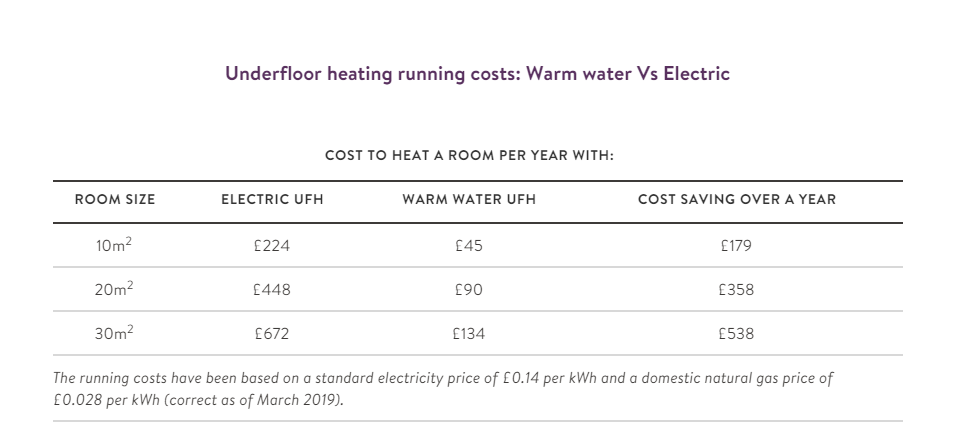
5.2 How to calculate heated area?
When you decide to install an underfloor heating mat in your kitchen room or living room, first, you need to calculate the heated area first.
Whether you are inviting a third-party decoration company, or if you personally design your home’s decor, you need to plan the area to be heated according to the layout of the room.
1) The area with obstacles should be excluded from the heating area. Areas to be excluded include counters, home appliance placement areas, furniture placement areas, etc.;
2) You need to have a precise wiring diagram to guide you to reserve an appropriate size area during installation;
If you DIY your electric floor heating, the following is a complete measurement case.
- Measure & estimate the breadth and length of your kitchen space.
- According to the formula, Area= Length X Width multiplies both values to get the total area.
- Give a try by providing heat to the specific area. You can subtract the area of the kitchen on which items are placed on heating mats from the total area.
- The resulting area you got is the proper measurement of the floor heating mat for your kitchen.
5.3 What else do I need if I decide DIY my electric floor heating?
In addition to the required heating mat, you will need some necessary accessories and tools during the installation process.
Tools: multimeter, resistor
Accessories: Insulation Board, Reflective Film
The maintenance cost of electric UFH is lower because it requires almost no maintenance. If the heating cable is not carefully checked during the actual installation, the refurbishment will be a headache.
You need to remove the floor, and you need to open the cement layer. Therefore, it is very necessary to perform the running test before and after the official application of cement mortar, which is also a necessary step for professional installation.
Chapter 6: Heating Mat FAQ’s
- Can I install it by myself?
Yes. underfloor heating mat is easy to install because it is a really-to-install product. You just roll out the mat then finish the installation. For more details, you can check our chapter 4.
- How do you install a warmup or other brands’ floor heating mat?
All installation methods for heating mats are similar or same. Chapter 4 is discussing how to install an underfloor heating mat. Please turn back and see.
- What we need to do if room size is more significant than the maximum size mat?
This problem can be broken down into two different situations:
1) We did not calculate the size of the area to be heated before purchasing
If this is the case, we can stop the current installation process and re-measure the installation area. Then go to the store and re-purchase the appropriate heating pad for tissue installation.
2) The area needs to be heated is indeed large, and the supply size on the market is currently small.
In this case, you can select two-piece of the heating mat and then connect them to different thermostats.
- Can I cut the heating mats?
Yes, you can cut the mats, but don’t forget you are just allowed to trim mats, not heating cables.
- Can we place the heating mats under weighty fixtures/items?
No. This would not affect the installation of the heating mat under the concrete floor, as it will be fixed in the cement mortar.
- What floor type can you use for an underfloor heating system?
Different floors really affect the choice of an electric floor heating system and the way it is installed, but this does not affect the type of floor you choose. You can choose favorite floor type first, and then choose the right type of underfloor heating mat.
- How can I heat my floor heat?
I think this question can be replaced by another question. That is, which kind of floor heating is better for me?
The answer to this question is very broad, but I can tell you that there are two different types of floor heating: water floor heating and electric floor heating.
1) Water-based Floor Heating: The plumbing mainly carries the heat from the boiler to the room through the pipeline. The fuel for heating the boiler here contains wood, gas, natural gas, and the like.
2) Electric floor heating is mainly through the heating line heating under the floor. The advantage of electric floor heating is that the conversion rate is 100%, and then automatic control can be achieved.
- Can you put electric floor heating under laminate?
Yes. Almost all electric floor heating needs to be fixed with cement mortar, and then various floors are installed on it.
- Do I Need temperature control?
Sure. A heating thermostat can help to regulate the heat output.
Conclusion
underfloor heating mat is an easy-to-install economical floor heat method, which is very suitable for all end consumers to DIY themselves. It is also suitable for non-professional distributors like floor distributors and building materials supermarkets to broaden their product category.
If you want to learn more about the underfloor heating mat, or are looking for a professional supplier, you are welcome to contact us by email: info@ahjiahong.com
